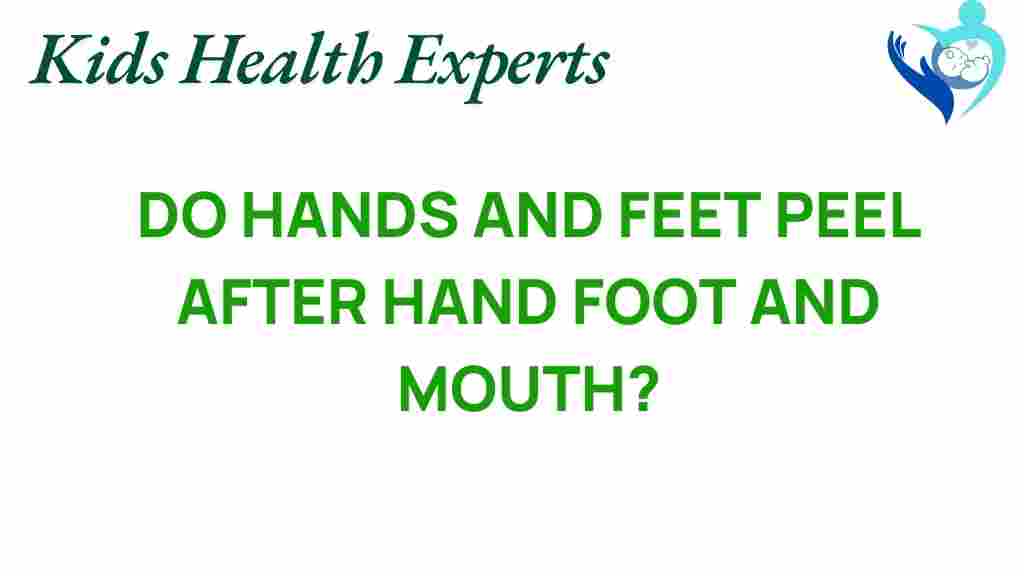Unraveling the Mystery: Do Hands and Feet Peel After Hand, Foot, and Mouth Disease?
Hand, Foot, and Mouth Disease (HFMD) is a common viral infection that primarily affects young children, though it can affect individuals of all ages. One of the many questions parents have when their child is diagnosed with this illness is whether peeling skin is a common symptom. In this article, we will explore the relationship between HFMD and skin peeling, the symptoms associated with this condition, and provide insights into pediatric health, recovery, and effective skin care.
Understanding Hand, Foot, and Mouth Disease
Hand, Foot, and Mouth Disease is caused by several types of viruses, most commonly coxsackievirus. The disease is highly contagious and spreads through direct contact with an infected person’s bodily fluids, such as saliva, nasal mucus, or fluid from blisters.
Symptoms of Hand, Foot, and Mouth Disease
The symptoms of HFMD typically appear three to seven days after exposure to the virus. Common symptoms include:
- Fever: Often the first sign, ranging from mild to high.
- Sore throat: Caused by ulcers that develop in the mouth.
- Mouth sores: Painful red spots can develop into ulcers.
- Rash: Typically appears on the hands and feet, and sometimes the buttocks and legs.
- Peeling skin: A less common symptom that may occur as the rash resolves.
Understanding these symptoms is crucial for parents to recognize HFMD and manage it effectively.
Do Hands and Feet Peel After Hand, Foot, and Mouth Disease?
The question of whether hands and feet peel after Hand, Foot, and Mouth Disease is common among parents. Yes, peeling skin can occur as part of the recovery process. Typically, this peeling happens after the rash and blisters have healed, and it is often a sign that the skin is regenerating.
Why Does Peeling Occur?
Peeling skin can be attributed to the following factors:
- Healing Process: As the blisters heal, the outer layer of skin may start to shed, leading to peeling.
- Inflammation: The inflammatory response to the viral infection can affect the skin’s integrity.
- Moisture Loss: The skin might be drier than usual post-infection, contributing to peeling.
In most cases, the peeling is benign and resolves on its own without the need for medical intervention.
Caring for Peeling Skin
Effective skin care during the recovery from Hand, Foot, and Mouth Disease is vital for comfort and healing. Here are some tips to manage peeling skin:
Step-by-Step Skin Care Routine
- Keep the area clean: Gently wash the affected areas with mild soap and warm water.
- Moisturize: Apply a fragrance-free hypoallergenic moisturizer to keep the skin hydrated.
- Avoid irritants: Keep children away from harsh chemicals or fragrances that may irritate the skin.
- Protect the skin: Use loose-fitting clothing to avoid friction on the peeling areas.
- Monitor for signs of infection: Watch for increased redness, swelling, or pus, and consult a pediatrician if these occur.
By following these steps, you can help ensure that your child’s skin heals properly and comfortably.
When to Seek Medical Advice
While most cases of Hand, Foot, and Mouth Disease resolve without complications, there are instances when medical advice is necessary. Consult a healthcare professional if:
- The child has a high fever that does not respond to medication.
- The child exhibits signs of dehydration (not drinking fluids, dry mouth, etc.).
- The peeling skin is accompanied by redness, swelling, or pus.
- The child experiences severe discomfort or pain.
Being vigilant about your child’s health and recognizing when to seek help is essential in managing pediatric health effectively.
Recovery from Hand, Foot, and Mouth Disease
Recovery from Hand, Foot, and Mouth Disease typically takes about 7 to 10 days. During this time, it is crucial to support your child’s recovery through:
- Hydration: Encourage fluid intake to prevent dehydration, especially if the child has mouth sores.
- Rest: Ensure the child gets plenty of sleep and relaxation to aid recovery.
- Nutrition: Offer soft, bland foods that are easy to swallow if the child has mouth pain.
Patience is key, as children may feel unwell during the peak of the infection, but proper care will facilitate a smooth recovery.
Preventing Hand, Foot, and Mouth Disease
Preventing the spread of Hand, Foot, and Mouth Disease is vital, particularly in settings like daycare centers or schools. Here are some effective strategies:
- Good hygiene: Encourage regular handwashing with soap and water.
- Avoid close contact: Keep infected children away from others until they are symptom-free.
- Disinfect surfaces: Regularly clean toys and surfaces that may be contaminated.
By implementing these preventive measures, you can help protect your child and others from this common viral infection.
Conclusion
In conclusion, peeling skin can indeed occur after Hand, Foot, and Mouth Disease as a part of the healing process. While the symptoms of HFMD can be uncomfortable, they are typically self-limiting and resolve within a week or two. Understanding the symptoms, caring for peeling skin, and knowing when to seek medical advice are essential components of managing your child’s health during this time. For more information on viral infections and pediatric health, you can visit Pediatric Health Resources.
By staying informed and proactive, parents can support their children through the recovery process and ensure a swift return to health. Remember that good hygiene practices are vital in preventing the spread of Hand, Foot, and Mouth Disease in the community.
This article is in the category Conditions and created by KidsHealthExperts Team
